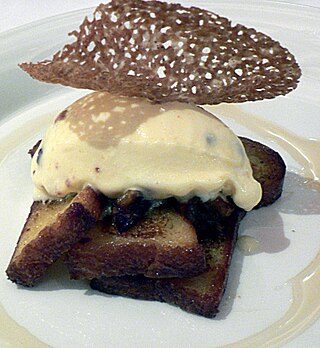
Ice cream is a frozen dessert typically made from milk or cream that has been flavoured with a sweetener, either sugar or an alternative, and a spice, such as cocoa or vanilla, or with fruit, such as strawberries or peaches. Food colouring is sometimes added in addition to stabilizers. The mixture is cooled below the freezing point of water and stirred to incorporate air spaces and prevent detectable ice crystals from forming. It can also be made by whisking a flavoured cream base and liquid nitrogen together. The result is a smooth, semi-solid foam that is solid at very low temperatures. It becomes more malleable as its temperature increases.
English grammar is the set of structural rules of the English language. This includes the structure of words, phrases, clauses, sentences, and whole texts.
The comma, is a punctuation mark that appears in several variants in different languages. Some typefaces render it as a small line, slightly curved or straight, but inclined from the vertical, others give it the appearance of a miniature filled-in figure 9; placed on the baseline. In many typefaces it is the same shape as an apostrophe or single closing quotation mark ’.
The semicolon; is a symbol commonly used as orthographic punctuation. In the English language, a semicolon is most commonly used to link two independent clauses that are closely related in thought, such as when restating the preceding idea with a different expression. When a semicolon joins two or more ideas in one sentence, those ideas are then given equal rank. Semicolons can also be used in place of commas to separate items in a list, particularly when the elements of the list themselves have embedded commas.
In grammar, a conjunction is a part of speech that connects words, phrases, or clauses, which are called its conjuncts. That description is vague enough to overlap with those of other parts of speech because what constitutes a "conjunction" must be defined for each language. In English, a given word may have several senses and in some contexts be a preposition but a conjunction in others, depending on the syntax. For example, after is a preposition in "he left after the fight" but a conjunction in "he left after they fought".

A 99 Flake, 99 or ninety-nine is an ice cream cone with a Cadbury Flake inserted in the ice cream. The term can also refer to the half-sized Cadbury-produced Flake bar, itself specially made for such ice cream cones, and to a wrapped product marketed by Cadbury “for ice cream and culinary use”.
In written English usage, a comma splice or comma fault is the use of a comma to join two independent clauses. For example:
It is nearly half past five, we cannot reach town before dark.
A final clause in linguistics is a dependent adverbial clause expressing purpose. For this reason it is also referred to as a purposive clause or a clause of purpose.
In linguistics and grammar, a sentence is a linguistic expression, such as the English example "The quick brown fox jumps over the lazy dog." In traditional grammar, it is typically defined as a string of words that expresses a complete thought, or as a unit consisting of a subject and predicate. In non-functional linguistics it is typically defined as a maximal unit of syntactic structure such as a constituent. In functional linguistics, it is defined as a unit of written texts delimited by graphological features such as upper-case letters and markers such as periods, question marks, and exclamation marks. This notion contrasts with a curve, which is delimited by phonologic features such as pitch and loudness and markers such as pauses; and with a clause, which is a sequence of words that represents some process going on throughout time. A sentence can include words grouped meaningfully to express a statement, question, exclamation, request, command, or suggestion.
A dependent clause, also known as a subordinate clause, subclause or embedded clause, is a certain type of clause that juxtaposes an independent clause within a complex sentence. For instance, in the sentence "I know Bette is a dolphin", the clause "Bette is a dolphin" occurs as the complement of the verb "know" rather than as a freestanding sentence. Subtypes of dependent clauses include content clauses, relative clauses, adverbial clauses, and clauses that complement an independent clause in the subjunctive mood.
Parataxis is a literary technique, in writing or speaking, that favors short, simple sentences, without conjunctions or with the use of coordinating, but not with subordinating conjunctions. It contrasts with syntaxis and hypotaxis.
Relative clauses in the English language are formed principally by means of relative words. The basic relative pronouns are who, which, and that; who also has the derived forms whom and whose. Various grammatical rules and style guides determine which relative pronouns may be suitable in various situations, especially for formal settings. In some cases the relative pronoun may be omitted and merely implied.
German sentence structure is the structure to which the German language adheres. German is an OV (Object-Verb) language. Additionally, German, like all west Germanic languages except English, uses V2 word order, though only in independent clauses. In dependent clauses, the finite verb is placed last.
The conditional mood is a grammatical mood used in conditional sentences to express a proposition whose validity is dependent on some condition, possibly counterfactual.
Zero-marking in English is the indication of a particular grammatical function by the absence of any morpheme. The most common types of zero-marking in English involve zero articles, zero relative pronouns, and zero subordinating conjunctions. Examples are I like cats in which the absence of the definite article, the, signals cats to be an indefinite reference, whose specific identity is not known to the listener; that's the cat I saw in which the relative clause (that) I saw omits the implied relative pronoun, that, which would otherwise be the object of the clause's verb; and I wish you were here. in which the dependent clause, (that) you were here, omits the subordinating conjunction, that.
In Latin grammar, the subjunctive by attraction is a name given when the verb in a relative clause or a temporal clause which is closely dependent on a subjunctive verb becomes subjunctive itself. The name also applies to subjunctives used when a subordinate clause is "so closely connected with an infinitive as to form an integral part of" it.

Bacon ice cream is an ice cream generally created by adding bacon to egg custard and freezing the mixture. The concept of bacon ice cream originated in a 1973 sketch on the British comedy series The Two Ronnies as a joke; it was eventually created for April Fools' Day by a New York ice cream parlour in 1982. In the 2000s, the English chef Heston Blumenthal experimented with ice cream, making a custard similar to scrambled eggs and adding bacon to create one of his signature dishes. It now appears on dessert menus in other restaurants.

This article describes the syntax of clauses in the English language, chiefly in Modern English. A clause is often said to be the smallest grammatical unit that can express a complete proposition. But this semantic idea of a clause leaves out much of English clause syntax. For example, clauses can be questions, but questions are not propositions. A syntactic description of an English clause is that it is a subject and a verb. But this too fails, as a clause need not have a subject, as with the imperative, and, in many theories, an English clause may be verbless. The idea of what qualifies varies between theories and has changed over time.

Prototypical conditional sentences in English are those of the form "If X, then Y". The clause X is referred to as the antecedent, while the clause Y is called the consequent. A conditional is understood as expressing its consequent under the temporary hypothetical assumption of its antecedent.
In grammar, sentence and clause structure, commonly known as sentence composition, is the classification of sentences based on the number and kind of clauses in their syntactic structure. Such division is an element of traditional grammar.



